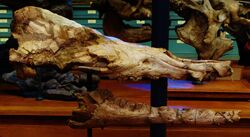Biology:Saghacetus
| Saghacetus | |
|---|---|

| |
| Skull of Saghacetus osiris at the Muséum national d'Histoire naturelle, Paris | |
| Scientific classification | |
| Domain: | Eukaryota |
| Kingdom: | Animalia |
| Phylum: | Chordata |
| Class: | Mammalia |
| Order: | Artiodactyla |
| Infraorder: | Cetacea |
| Family: | †Basilosauridae |
| Subfamily: | †Dorudontinae |
| Genus: | †Saghacetus Gingerich 1992 |
| Species | |
|
S. osiris (type) | |
| Synonyms[1] | |
| |
Saghacetus is an extinct genus of basilosaurid early whale, fossils of which have been found in the Upper Eocene (middle Priabonian, 37.2 to 33.9 million years ago) Qasr el Sagha Formation, Egypt ( [ ⚑ ] 29°42′N 30°48′E / 29.7°N 30.8°E, paleocoordinates [ ⚑ ] 25°00′N 26°42′E / 25.0°N 26.7°E).[2][3]
Discovery

In 1879, German botanist Georg August Schweinfurth spent many years exploring Africa and eventually discovered the first archaeocete whale in Egypt. He visited Qasr el Sagha in 1884 and 1886 and missed the now famous "Zeuglodon Valley" with a few kilometres. German palaeontologist Wilhelm Barnim Dames described the material,[4] including a well-preserved dentary which is the type specimen of Zeuglodon osiris.[5]
The generic name Saghacetus was established by Gingerich 1992[6] to group the ancient species Dorudon osiris, D. zitteli, D. sensitivius and D. elliotsmithii on a single species, Saghacetus osiris. This species is distinguished from other members of the subfamily Dorudontinae by its smaller size and the slightly elongated proximal lumbar and caudal vertebrae.[7]
Description
Saghacetus was a small whale, reaching 4 m (13 ft) in length and 350–379 kg (772–836 lb) in body mass.[7][8] It was smaller than its contemporary Stromerius, both of which are smaller than the older Dorudon.[9]
Notes
- ↑ Saghacetus osiris in the Paleobiology Database. Retrieved May 2013.
- ↑ Saghacetus in the Paleobiology Database. Retrieved May 2013.
- ↑ Tamariskenbucht (Eocene of Egypt) in the Paleobiology Database. Retrieved July 2013.
- ↑ Dames 1883a; Dames 1883b, pp. 130–135; Dames 1894
- ↑ Gingerich 2007, pp. 110–112
- ↑ Gingerich 1992, p. 73
- ↑ 7.0 7.1 Uhen 2008, p. 91–94
- ↑ Waugh & Thewissen 2021
- ↑ Gingerich 2007, Diagnosis, p. 368
References
- "Ein Epistropheus von Zeuglodon sp". Sitzungsberichte der Gesellschaft Naturforschender Freunde zu Berlin: 3. 1883a. https://archive.org/stream/sitzungsberichte1883gese#page/2/mode/2up. Retrieved September 22, 2013.
- Dames, W. B. (1883b). "Über eine tertiäre Wirbelthierfauna von der westlichen Insel des Birket-el-Qurūn im Fajum (Aepgypten)". Sitzungsberichte der Königlich Preußischen Akademie der Wissenschaften: 129–153. https://www.biodiversitylibrary.org/item/93358#page/154/mode/2up. Retrieved September 22, 2013.
- "Ueber Zeuglodonten aus Aegypten und die Beziehungen der Archaeoceten zu den übrigen Cetaceen". Geologische und Paläontologische Abhandlungen (Jena) 5: 189–222. 1894. https://www.biodiversitylibrary.org/item/42224#page/204/mode/2up. Retrieved September 22, 2013. (plates)
- "Marine Mammals (Cetacean and Sirenia) from the Eocene of Gebel Mokattam and Fayum, Egypt: Stratigraphy, Age, and Paleoenvironments". University of Michigan Papers on Paleontology 30: 1–84. 1992. OCLC 26941847.
- Gingerich, P. D. (2007). "Stromerius nidensis, new archaeocete (Mammalia, Cetacea) from the Upper Eocene Qasr El-Sagha Formation, Fayum, Egypt". Contributions from the Museum of Paleontology 31 (13): 363–78. OCLC 214233870. http://deepblue.lib.umich.edu/bitstream/2027.42/57499/1/Vol%2031%20No%2013%20final%2012-19-07.pdf.
- Perrin, William F.; Wursig, Bernd; Thewissen, J.G.M., eds (2008). "Basilosaurids". Encyclopedia of Marine Mammals (2nd ed.). Academic Press. pp. 91–94. ISBN 978-0-12-373553-9. https://books.google.com/books?id=2rkHQpToi9sC&q=Basilosaurus&pg=PA93.
- Waugh, D.A.; Thewissen, J.G.M. (2021). "The Pattern of Brain-size Change in the Early Evolution of Cetaceans". PLOS ONE 16 (9): e0257803. doi:10.1371/journal.pone.0257803.
Wikidata ☰ Q3763133 entry
 |


